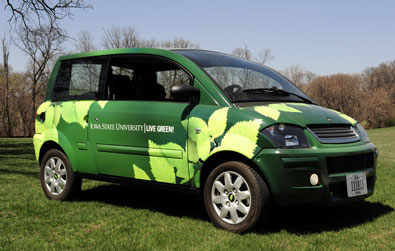Inside Iowa State
Inside ArchivesSubmit newsSend news for Inside to inside@iastate.edu, or call (515) 294-7065. See publication dates, deadlines. About InsideInside Iowa State, a newspaper for faculty and staff, is published by the Office of University Relations. |
May 1, 2009 
University units interested in test driving an electric car -- this one, in fact -- may contact Bill Diesslin, EHS, 4-2105. Photo by Bob Elbert. Checking in on the electric fleetby Anne Krapfl Six months after they arrived on campus, electric vehicles are fitting into some niche uses. They can't replace the larger combustion-engine cars and trucks -- and that isn't the intent -- but those who use them say they do a good job moving people and supplies across campus. Facilities planning and management and transportation services each purchased an electric car and truck last fall. FPM maintains its own vehicles and transportation services leases its two to the environmental health and safety department. "They've been well received by people. For a bulk of what they do, the vehicles are a good substitute," said Bob Currie, assistant director of facilities services. "There are some behavior adjustments that have to happen," he said, noting that options such as power steering, power windows or a radio mostly are absent in the ISU electric vehicles but usually standard equipment in gasoline-powered vehicles. Great performanceCurrie and EHS assistant director Bill Diesslin said their vehicles survived the test of winter. They were plugged in outside overnight and fully charged in six to eight hours. Even on the coldest mornings, the electric vehicles started without incident and ran well throughout the day without ever using up their electrical charges. Currie said the heaters are sufficient to defrost the windows. However, heating the vehicles on cold winter days drained the battery system more rapidly, so employees changed their expectations about driving in a toasty warm vehicle. "Once we get people out of the mindset that these have to be like gas-powered vehicles, they grab hold of them," Diesslin said. Cost comparisonFPM purchased metering equipment to track the kilowatt hours -- and dollars -- used to keep the electrical vehicles charged. Currie then compares that data with gas consumption for the rest of the fleet. An electric vehicle uses about 13 cents worth of electricity per day to stay charged. On average, vehicles in the gasoline-powered fleet -- pickup trucks, minivans and "Gator"-type utility vehicles -- use $3.49 worth of fuel daily. Neither calculation includes routine maintenance. Currie estimated that on gas savings alone, an electric vehicle could retrieve its higher sticker price in about five years. Currie's data also includes notes about emissions. His combustion engine vehicles, on average, each emit about 3.4 tons of carbon dioxide annually. Electric vehicles don't score a perfect zero in that category, but they come close. What can't it do?Electrical vehicles aren't built for racing. Top speed is about 25 mph and, legally, the vehicles only can operate on roads with posted speed limits of 35 mph or less. Believe it or not, you can get to Vet Med or Lowe's Home Improvement from central campus and still obey this rule. Currie said the purchase price remains a hindrance as well. The $17,000 to $21,000 Iowa State paid for each of the first four electric vehicles isn't exactly high end. But when the university can replace vehicles in its pickup fleet for $12,000 to $14,000, the electric cars seem a little spendy. "We'll continue to make these available on campus, share our story and hope that demand for them starts to drive the price down," he said. Will there be more?Currie said nearly 90 FPM employees have received training to drive the electric vehicles. Its four-passenger car has been rotated into a three-car pool available for daily movement around campus. The open-back truck, used extensively by grounds crews this winter, currently is used by staff in the carpenter shop to haul supplies and tools across campus. The enclosed truck in EHS is used by staff who service fire extinguishers and test lab fume hoods across campus. The two-seat car, which sports the 100 percent recyclable "Live Green" wrap, is used by staff to get across campus. Diesslin also uses it frequently in class demonstrations and test drives for university units that inquire about electric vehicles. |
Quote"They've been well received by people. For a bulk of what they do, the vehicles are a good substitute." Bob Currie, assistant director of facilities services |